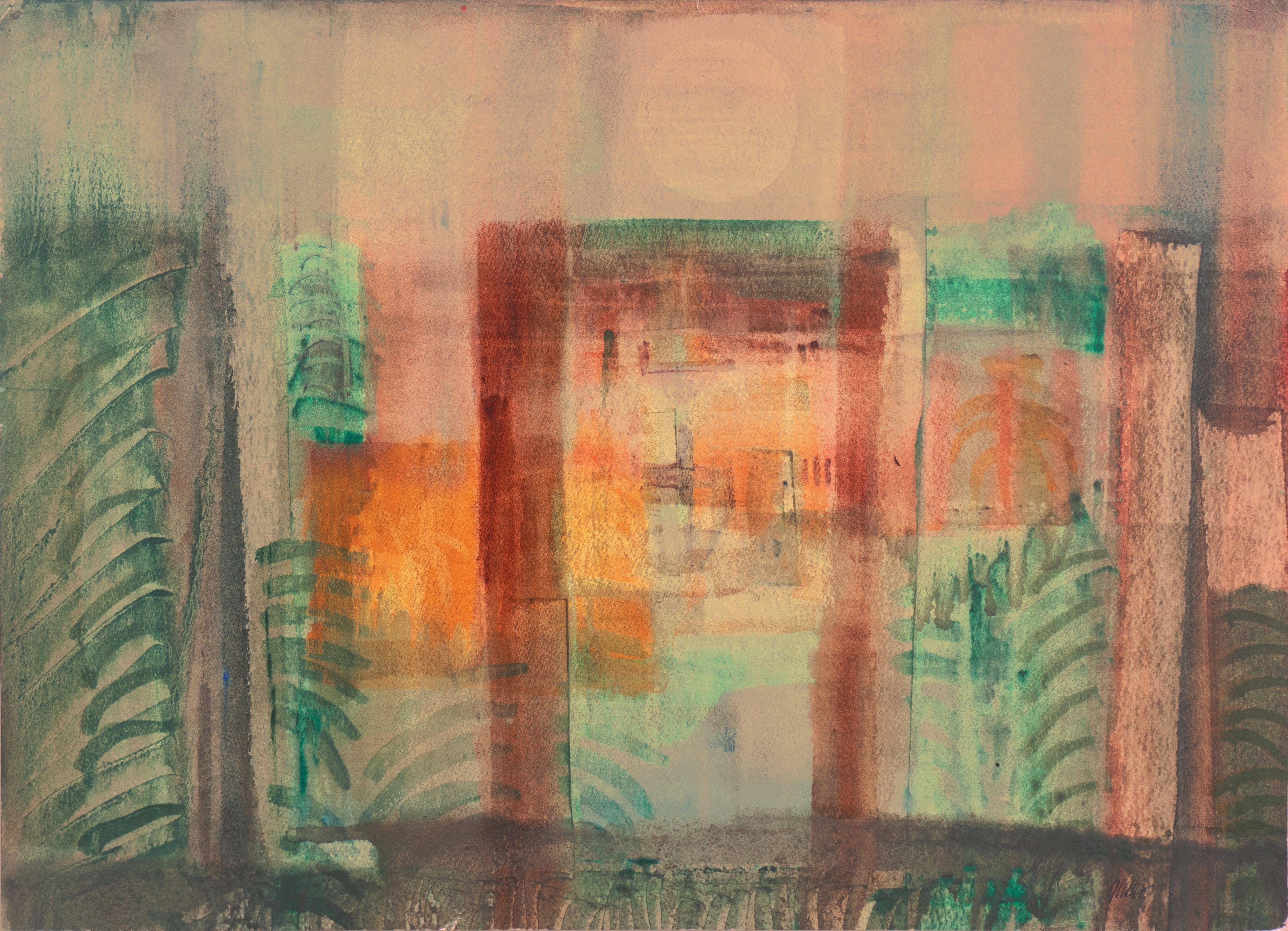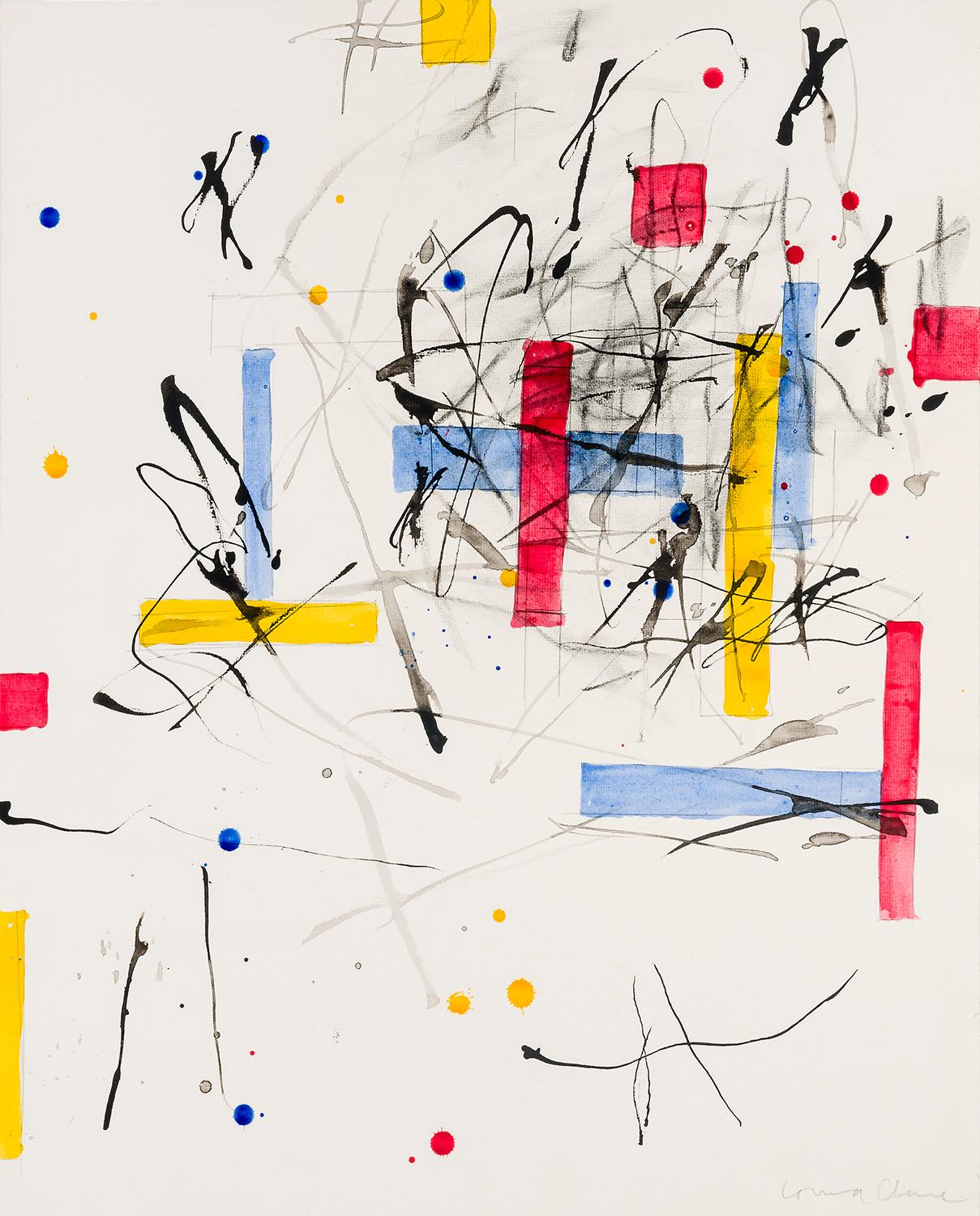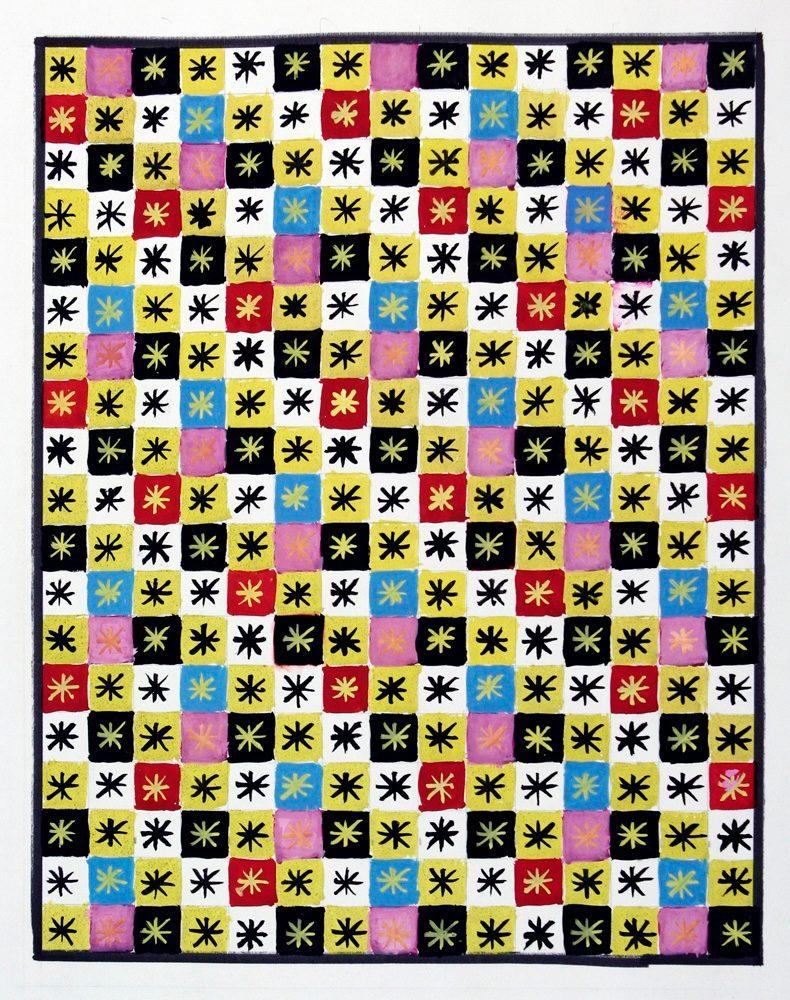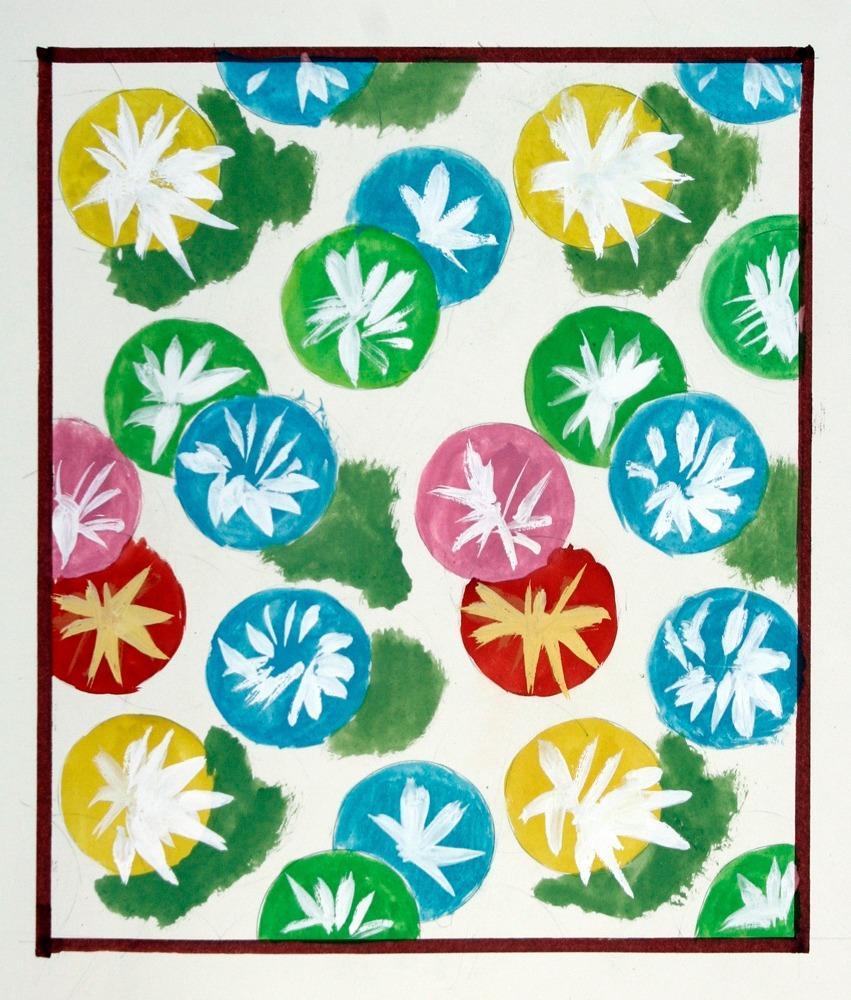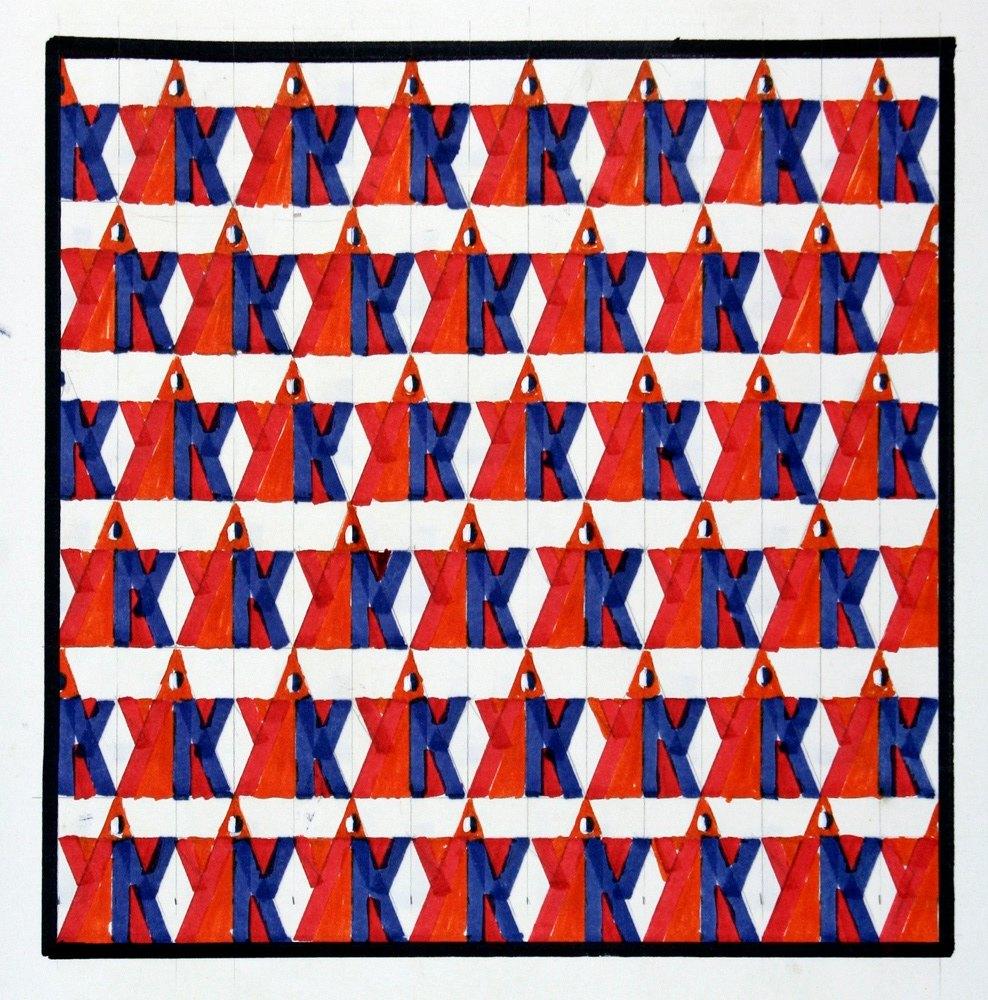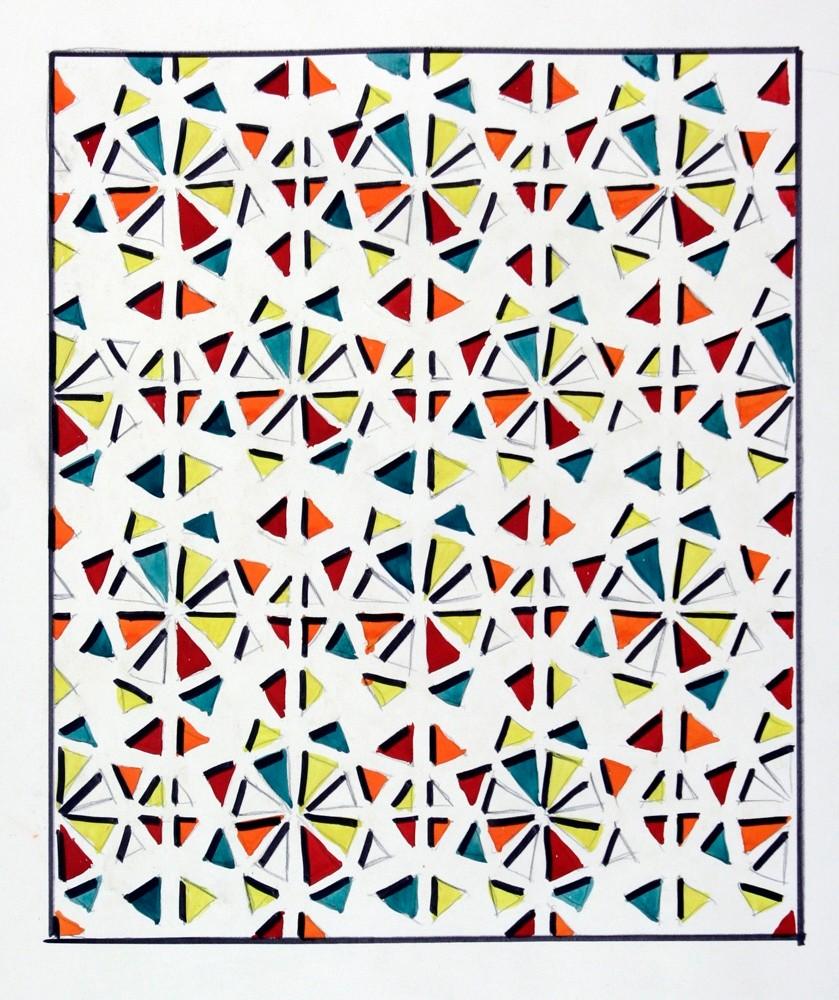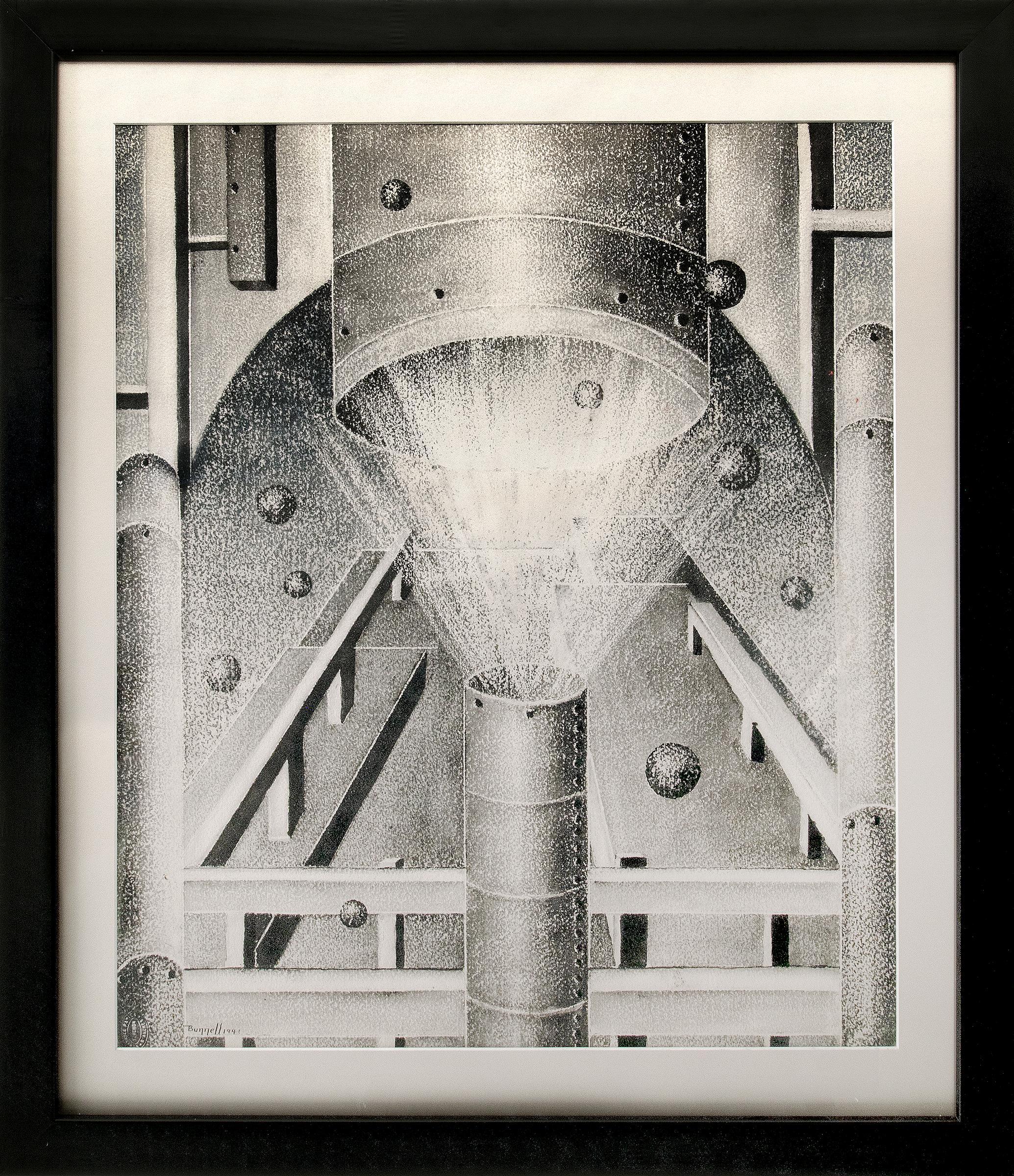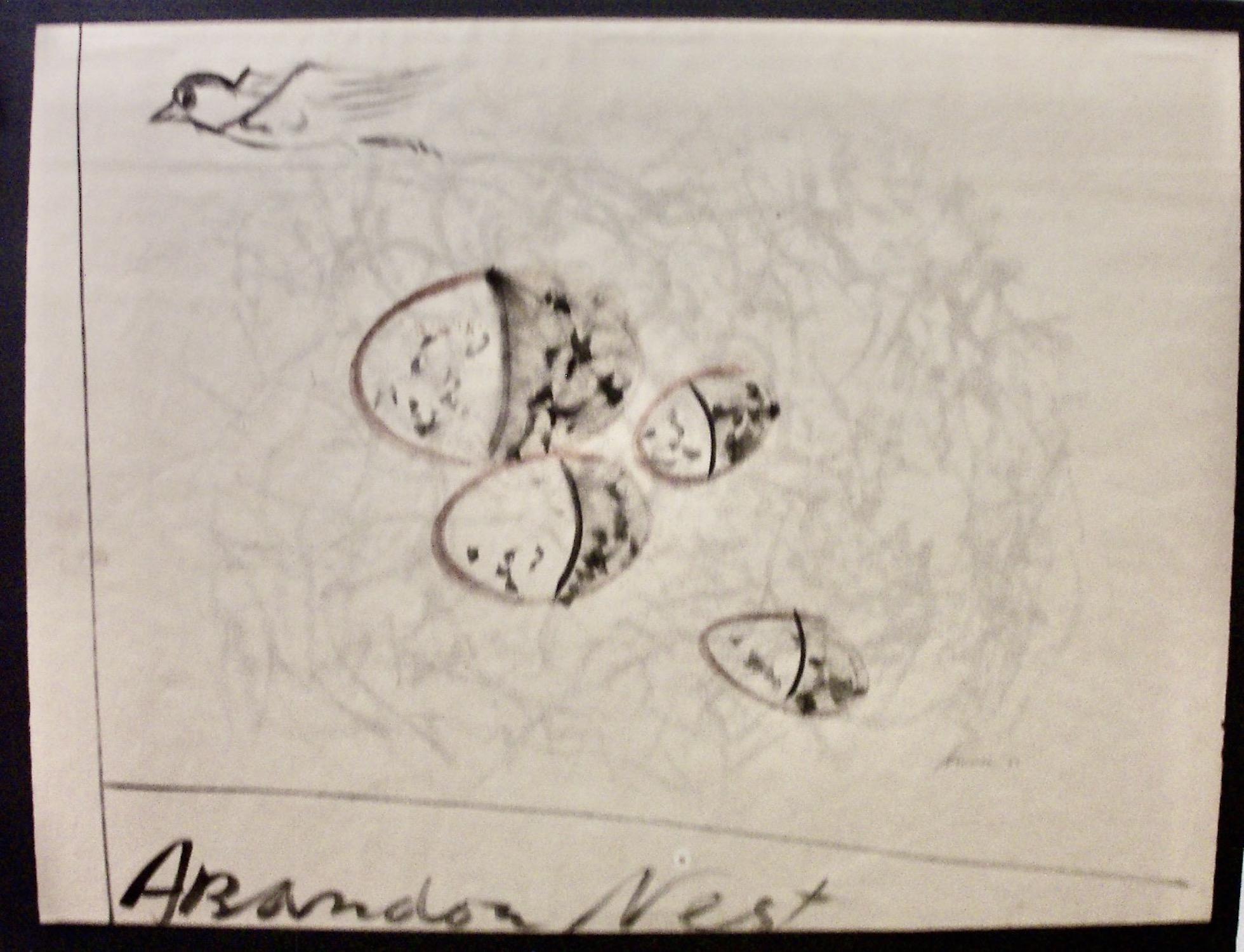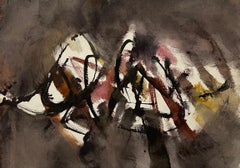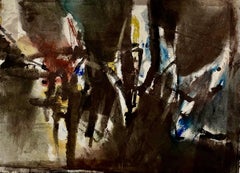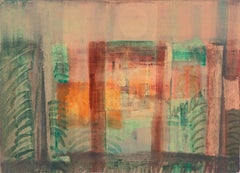
WPA Woman Artist "Santorini Street" Modernist Abstract Watercolor of Houses
View Similar Items
Riva HelfondWPA Woman Artist "Santorini Street" Modernist Abstract Watercolor of Houses
About the Item
- Creator:Riva Helfond (1910-2002, American)
- Dimensions:Height: 30 in (76.2 cm)Width: 24.25 in (61.6 cm)
- Medium:
- Movement & Style:
- Period:
- Condition:minor wear to frame commensurate with age and use.
- Gallery Location:Surfside, FL
- Reference Number:Seller: 5741stDibs: LU3822385571
Riva Helfond
Riva Helfond, painter, printmaker and educator, was born in Brooklyn. She studied at the School of Industrial Art and the Art Students League, both in New York. Helfond taught in the WPA/FAP programs in New York from 1936–41 and was on the creative staff of their graphics division. In 1964, she taught printmaking at New York University, and since 1980, has been on the faculty of Union College, Cranford, New Jersey. Her work can be seen in the collections of the California State Museum, Los Angeles; Carnegie Institute, Pittsburgh; Cincinnati Museum; Georgetown University, Washington, D.C.; Metropolitan Museum of Art; Miami Museum of Fine Art; Museum of Modern Art; Library of Congress, Washington, D.C.; Miami Center for Fine Arts; New York Public Library, Print Collection and the Boston Public Library Print Collection. Helfond has exhibited widely and is the recipient of numerous awards, most recently the Society of American Graphic Artists Award for Outstanding Collograph. Her work is included in the Archives of American Art.
- Modernist Abstract Expressionist Watercolor Painting Bauhaus Weimar ArtistBy Pawel KontnyLocated in Surfside, FLAbstract watercolor composition bearing the influence of the earlier color-block compositions of Paul Klee. Pawel August Kontny, (Polish-German-American artist) He was born in Laurahuette, Poland, in 1923, the son of a wealthy pastry shop owner. In 1939 he began studying architecture in Breslau where he was introduced to the European masters and to the work of some of the German Expressionists, soon afterward banned as "degenerate artists" and removed from museums throughout Germany by the Nazi regime. His studies were interrupted by World War II. Drafted into the German army, traveling in many countries as a soldier, he sketched various landscapes but in 1945, he was captured and held as a prisoner of war in Italy. After the war, he studied at the Union of Nuremberg Architects to help design buildings to replace ones destroyed in the war. He recorded his impressions of the local population and the landscapes through his watercolors and drawings. Pawel Kontny thereafter moved to Nuremberg, Germany, becoming a member of the Union of Nuremberg Architects and helping to rebuild the city's historic center. He soon decided to concentrate on his professional art career. He married Irmgard Laurer, a dancer with the Nuremberg Opera. Pavel Kontny 's career as an artist was launched with his participation in an all German exhibition, held at the Dusseldorf Museum in 1952. He held one-man shows in Germany, Switzerland and the United States. During his trip to the United States in 1960, Kontny became instantly enamored with Colorado, and decided to relocate to Cherry Hills with his wife and two children. He quickly established himself in the local art community, being affiliated for a time with Denver Art Galleries and Saks Galleries. His subject matter became the Southwest. During this time he received the Prestigious Gold Medal of the Art Academy of Rome. His extensive travel provided material for the paintings he did using his hallmark marble dust technique. he also worked equally in pastel, watercolor, charcoal and pencil-and-ink. in a style which merged abstraction and realist styles, influenced by Abstract Expressionist painting and South Western American landscapes. In the early 1960s he was one of only a few European-born professional artists in the state, a select group that included Herbert Bayer (1900-1985), a member of the prewar Bauhaus in Weimar and Dessau, Germany, and Roland Detre (1903-2001), a Hungarian modernist painter. As a Denver, Colorado resident, Pavel Kontny exhibited at galleries and museums throughout the United States, Germany and Japan. There, he was inspired by frequent trips to Native American pueblos in the Southwest, as well as by the study of the Plains Indians of Montana and Wyoming. Over the years Kontny had a number of students and generously helped young artist by hosting exhibitions at his Cherry Hills home. For many years he generously donated his paintings to support charitable causes in Denver. Influences during his European years included German pastelist C.O. Muller, German Informel painter Karl Dahmen and Swiss artist, Hans Erni. In the early 1950s his painting style showed the influence of the Die Brücke (The Bridge), a group of German expressionist artists formed in Dresden in 1905 who had a major impact on the evolution of modern art in the twentieth century in Germany. By the middle of the decade his style incorporated more referential abstraction and total abstraction, resulting in part from his study of Hans Hartung, a German artist based in Paris who exhibited his gestural abstract work in Germany. His work also bears the influence of Sam Francis. The American moon landing in 1969 inspired Paul Kontny...Category
Mid-20th Century American Modern Abstract Drawings and Watercolors
MaterialsWatercolor, Archival Paper
- Modernist Abstract Expressionist Watercolor Painting Bauhaus Weimar Pawel KontnyBy Pawel KontnyLocated in Surfside, FLAbstract watercolor composition bearing the influence of the earlier color-block compositions of Paul Klee. Pawel August Kontny, (Polish-German-American artist) He was born in Laurahuette, Poland, in 1923, the son of a wealthy pastry shop owner. In 1939 he began studying architecture in Breslau where he was introduced to the European masters and to the work of some of the German Expressionists, soon afterward banned as "degenerate artists" and removed from museums throughout Germany by the Nazi regime. His studies were interrupted by World War II. Drafted into the German army, traveling in many countries as a soldier, he sketched various landscapes but in 1945, he was captured and held as a prisoner of war in Italy. After the war, he studied at the Union of Nuremberg Architects to help design buildings to replace ones destroyed in the war. He recorded his impressions of the local population and the landscapes through his watercolors and drawings. Pawel Kontny thereafter moved to Nuremberg, Germany, becoming a member of the Union of Nuremberg Architects and helping to rebuild the city's historic center. He soon decided to concentrate on his professional art career. He married Irmgard Laurer, a dancer with the Nuremberg Opera. Pavel Kontny 's career as an artist was launched with his participation in an all German exhibition, held at the Dusseldorf Museum in 1952. He held one-man shows in Germany, Switzerland and the United States. During his trip to the United States in 1960, Kontny became instantly enamored with Colorado, and decided to relocate to Cherry Hills with his wife and two children. He quickly established himself in the local art community, being affiliated for a time with Denver Art Galleries and Saks Galleries. His subject matter became the Southwest. During this time he received the Prestigious Gold Medal of the Art Academy of Rome. His extensive travel provided material for the paintings he did using his hallmark marble dust technique. he also worked equally in pastel, watercolor, charcoal and pencil-and-ink. in a style which merged abstraction and realist styles, influenced by Abstract Expressionist painting and South Western American landscapes. This one bears the influence of Sam Francis. In the early 1960s he was one of only a few European-born professional artists in the state, a select group that included Herbert Bayer (1900-1985), a member of the prewar Bauhaus in Weimar and Dessau, Germany, and Roland Detre (1903-2001), a Hungarian modernist painter. As a Denver, Colorado resident, Pavel Kontny exhibited at galleries and museums throughout the United States, Germany and Japan. There, he was inspired by frequent trips to Native American pueblos in the Southwest, as well as by the study of the Plains Indians of Montana and Wyoming. Over the years Kontny had a number of students and generously helped young artist by hosting exhibitions at his Cherry Hills home. For many years he generously donated his paintings to support charitable causes in Denver. Influences during his European years included German pastelist C.O. Muller, German Informel painter Karl Dahmen and Swiss artist, Hans Erni. In the early 1950s his painting style showed the influence of the Die Brücke (The Bridge), a group of German expressionist artists formed in Dresden in 1905 who had a major impact on the evolution of modern art in the twentieth century in Germany. By the middle of the decade his style incorporated more referential abstraction and total abstraction, resulting in part from his study of Hans Hartung, a German artist based in Paris who exhibited his gestural abstract work in Germany. The American moon landing in 1969 inspired Paul Kontny...Category
20th Century American Modern Abstract Drawings and Watercolors
MaterialsWatercolor, Archival Paper
- Modernist Abstract Expressionist Watercolor Painting Bauhaus Weimar Pawel KontnyBy Pawel KontnyLocated in Surfside, FLAbstract watercolor composition bearing the influence of the earlier color-block compositions of Paul Klee. Pawel August Kontny, (Polish-German-American artist) He was born in Laurahuette, Poland, in 1923, the son of a wealthy pastry shop owner. In 1939 he began studying architecture in Breslau where he was introduced to the European masters and to the work of some of the German Expressionists, soon afterward banned as "degenerate artists" and removed from museums throughout Germany by the Nazi regime. His studies were interrupted by World War II. Drafted into the German army, traveling in many countries as a soldier, he sketched various landscapes but in 1945, he was captured and held as a prisoner of war in Italy. After the war, he studied at the Union of Nuremberg Architects to help design buildings to replace ones destroyed in the war. He recorded his impressions of the local population and the landscapes through his watercolors and drawings. Pawel Kontny thereafter moved to Nuremberg, Germany, becoming a member of the Union of Nuremberg Architects and helping to rebuild the city's historic center. He soon decided to concentrate on his professional art career. He married Irmgard Laurer, a dancer with the Nuremberg Opera. Pavel Kontny 's career as an artist was launched with his participation in an all German exhibition, held at the Dusseldorf Museum in 1952. He held one-man shows in Germany, Switzerland and the United States. During his trip to the United States in 1960, Kontny became instantly enamored with Colorado, and decided to relocate to Cherry Hills with his wife and two children. He quickly established himself in the local art community, being affiliated for a time with Denver Art Galleries and Saks Galleries. His subject matter became the Southwest. During this time he received the Prestigious Gold Medal of the Art Academy of Rome. His extensive travel provided material for the paintings he did using his hallmark marble dust technique. he also worked equally in pastel, watercolor, charcoal and pencil-and-ink. in a style which merged abstraction and realist styles, influenced by Abstract Expressionist painting and South Western American landscapes. This one bears the influence of Sam Francis. In the early 1960s he was one of only a few European-born professional artists in the state, a select group that included Herbert Bayer (1900-1985), a member of the prewar Bauhaus in Weimar and Dessau, Germany, and Roland Detre (1903-2001), a Hungarian modernist painter. As a Denver, Colorado resident, Pavel Kontny exhibited at galleries and museums throughout the United States, Germany and Japan. There, he was inspired by frequent trips to Native American pueblos in the Southwest, as well as by the study of the Plains Indians of Montana and Wyoming. Over the years Kontny had a number of students and generously helped young artist by hosting exhibitions at his Cherry Hills home. For many years he generously donated his paintings to support charitable causes in Denver. Influences during his European years included German pastelist C.O. Muller, German Informel painter Karl Dahmen and Swiss artist, Hans Erni. In the early 1950s his painting style showed the influence of the Die Brücke (The Bridge), a group of German expressionist artists formed in Dresden in 1905 who had a major impact on the evolution of modern art in the twentieth century in Germany. By the middle of the decade his style incorporated more referential abstraction and total abstraction, resulting in part from his study of Hans Hartung, a German artist based in Paris who exhibited his gestural abstract work in Germany. The American moon landing in 1969 inspired Paul Kontny...Category
20th Century American Modern Abstract Drawings and Watercolors
MaterialsWatercolor, Archival Paper
- Modernist Abstract Expressionist Watercolor Painting Bauhaus Weimar Pawel KontnyBy Pawel KontnyLocated in Surfside, FLAbstract watercolor composition bearing the influence of the earlier color-block compositions of Paul Klee. Pawel August Kontny, (Polish-German-American artist) He was born in Laurahuette, Poland, in 1923, the son of a wealthy pastry shop owner. In 1939 he began studying architecture in Breslau where he was introduced to the European masters and to the work of some of the German Expressionists, soon afterward banned as "degenerate artists" and removed from museums throughout Germany by the Nazi regime. His studies were interrupted by World War II. Drafted into the German army, traveling in many countries as a soldier, he sketched various landscapes but in 1945, he was captured and held as a prisoner of war in Italy. After the war, he studied at the Union of Nuremberg Architects to help design buildings to replace ones destroyed in the war. He recorded his impressions of the local population and the landscapes through his watercolors and drawings. Pawel Kontny thereafter moved to Nuremberg, Germany, becoming a member of the Union of Nuremberg Architects and helping to rebuild the city's historic center. He soon decided to concentrate on his professional art career. He married Irmgard Laurer, a dancer with the Nuremberg Opera. Pavel Kontny 's career as an artist was launched with his participation in an all German exhibition, held at the Dusseldorf Museum in 1952. He held one-man shows in Germany, Switzerland and the United States. During his trip to the United States in 1960, Kontny became instantly enamored with Colorado, and decided to relocate to Cherry Hills with his wife and two children. He quickly established himself in the local art community, being affiliated for a time with Denver Art Galleries and Saks Galleries. His subject matter became the Southwest. During this time he received the Prestigious Gold Medal of the Art Academy of Rome. His extensive travel provided material for the paintings he did using his hallmark marble dust technique. he also worked equally in pastel, watercolor, charcoal and pencil-and-ink. in a style which merged abstraction and realist styles, influenced by Abstract Expressionist painting and South Western American landscapes. This one bears the influence of Sam Francis. In the early 1960s he was one of only a few European-born professional artists in the state, a select group that included Herbert Bayer (1900-1985), a member of the prewar Bauhaus in Weimar and Dessau, Germany, and Roland Detre (1903-2001), a Hungarian modernist painter. As a Denver, Colorado resident, Pavel Kontny exhibited at galleries and museums throughout the United States, Germany and Japan. There, he was inspired by frequent trips to Native American pueblos in the Southwest, as well as by the study of the Plains Indians of Montana and Wyoming. Over the years Kontny had a number of students and generously helped young artist by hosting exhibitions at his Cherry Hills home. For many years he generously donated his paintings to support charitable causes in Denver. Influences during his European years included German pastelist C.O. Muller, German Informel painter Karl Dahmen and Swiss artist, Hans Erni. In the early 1950s his painting style showed the influence of the Die Brücke (The Bridge), a group of German expressionist artists formed in Dresden in 1905 who had a major impact on the evolution of modern art in the twentieth century in Germany. By the middle of the decade his style incorporated more referential abstraction and total abstraction, resulting in part from his study of Hans Hartung, a German artist based in Paris who exhibited his gestural abstract work in Germany. The American moon landing in 1969 inspired Paul Kontny...Category
20th Century American Modern Abstract Drawings and Watercolors
MaterialsWatercolor, Archival Paper
- Large Modernist Abstract Expressionist Gouache Painting Bauhaus Weimar ArtistBy Pawel KontnyLocated in Surfside, FLAbstract watercolor or gouache composition bearing the influence of the earlier color-block compositions of Paul Klee. Pawel August Kontny, (Polish-German-American artist) He was born in Laurahuette, Poland, in 1923, the son of a wealthy pastry shop owner. In 1939 he began studying architecture in Breslau where he was introduced to the European masters and to the work of some of the German Expressionists, soon afterward banned as "degenerate artists" and removed from museums throughout Germany by the Nazi regime. His studies were interrupted by World War II. Drafted into the German army, traveling in many countries as a soldier, he sketched various landscapes but in 1945, he was captured and held as a prisoner of war in Italy. After the war, he studied at the Union of Nuremberg Architects to help design buildings to replace ones destroyed in the war. He recorded his impressions of the local population and the landscapes through his watercolors and drawings. Pawel Kontny thereafter moved to Nuremberg, Germany, becoming a member of the Union of Nuremberg Architects and helping to rebuild the city's historic center. He soon decided to concentrate on his professional art career. He married Irmgard Laurer, a dancer with the Nuremberg Opera. Pavel Kontny 's career as an artist was launched with his participation in an all German exhibition, held at the Dusseldorf Museum in 1952. He held one-man shows in Germany, Switzerland and the United States. During his trip to the United States in 1960, Kontny became instantly enamored with Colorado, and decided to relocate to Cherry Hills with his wife and two children. He quickly established himself in the local art community, being affiliated for a time with Denver Art Galleries and Saks Galleries. His subject matter became the Southwest. During this time he received the Prestigious Gold Medal of the Art Academy of Rome. His extensive travel provided material for the paintings he did using his hallmark marble dust technique. he also worked equally in pastel, watercolor, charcoal and pencil-and-ink. in a style which merged abstraction and realist styles, influenced by Abstract Expressionist painting and South Western American landscapes. In the early 1960s he was one of only a few European-born professional artists in the state, a select group that included Herbert Bayer (1900-1985), a member of the prewar Bauhaus in Weimar and Dessau, Germany, and Roland Detre (1903-2001), a Hungarian modernist painter. As a Denver, Colorado resident, Pavel Kontny exhibited at galleries and museums throughout the United States, Germany and Japan. There, he was inspired by frequent trips to Native American pueblos in the Southwest, as well as by the study of the Plains Indians of Montana and Wyoming. Over the years Kontny had a number of students and generously helped young artist by hosting exhibitions at his Cherry Hills home. For many years he generously donated his paintings to support charitable causes in Denver. Influences during his European years included German pastelist C.O. Muller, German Informel painter Karl Dahmen and Swiss artist, Hans Erni. In the early 1950s his painting style showed the influence of the Die Brücke (The Bridge), a group of German expressionist artists formed in Dresden in 1905 who had a major impact on the evolution of modern art in the twentieth century in Germany. By the middle of the decade his style incorporated more referential abstraction and total abstraction, resulting in part from his study of Hans Hartung, a German artist based in Paris who exhibited his gestural abstract work in Germany. The American moon landing in 1969 inspired Paul Kontny...Category
20th Century American Modern Landscape Paintings
MaterialsWatercolor, Archival Paper
- Original California Figurative Abstract Still Life Ink Drawing Joyce TreimanBy Joyce TreimanLocated in Surfside, FLJoyce Treiman Ink on paper, framed under glass; signed in pencil lower right; Dimensions: 16 1/2 x 13 3/4 inches; 18 3/4 x 14 3/4 inches frame. Joyce Wahl Treiman was an American painter, printmaker, sculptor and teacher. Her work ranged from "the impishly perverse and humorously paradoxical to the brilliant and profound." She was known as an excellent draftsperson throughout her career. She made several trips to Europe to study the old masters, and the human figure is central in her work. In her later paintings she is known to have inserted self-portraits. She attended Stephens College in Columbia, Missouri, and then studied at the State University of Iowa (today the University of Iowa) under the influential painter Philip Guston. During World War II she worked as a commercial artist but resigned when she began to have success with exhibitions of her work in Chicago and New York. In 1945 she married Kenneth Treiman, and son Donald, now an Architect, was born in 1950. The Treimans, along with Rene and Rose Wahl, moved to Los Angeles in 1960. She was in an exhibit of Tamarind prints...Category
Mid-20th Century American Modern Abstract Paintings
MaterialsIndia Ink, Paper
- Horse and TreeBy Robert Noel BlairLocated in Buffalo, NYYou are viewing a modernist American watercolor painting by Robert Noel Blair Robert Noel Blair (American, 1912-2003) was an American artist, painter, sculptor, printmaker and te...Category
1960s American Modern Abstract Drawings and Watercolors
MaterialsArchival Ink, Paper, Watercolor
- Golf Bags, Caddy with Golf Bag on His BackBy Frederick ConwayLocated in Missouri, MOFramed Size: approx 17 3/4 x 20 3/4 inches Fred Conway (1900-1973) "Golf Bags, Caddy with Golf Bag on His Back" Pen/Ink/Watercolor on Paper Site Size: approx. 10 x 13 inches Framed Size: approx. 17 3/4 x 20 3/4 inches A member of the faculty of the Washington University Art School from 1929 to 1970, Frederick Conway...Category
1960s American Modern Figurative Drawings and Watercolors
MaterialsPaper, Ink, Watercolor, Pen
- 'Evening Landscape' Bay Area Abstraction, San Francisco Museum of Fine Arts, CWSBy Robert George GilbergLocated in Santa Cruz, CASigned lower right, 'Gilberg' for Robert George Gilberg (American, 1911-1970) and painted circa 1965. Born in Oakland, Robert George Gilberg first studied at the Oakland Art Center during the 1930s. Following service during WWII, he settled in Nevada City, California where he lived and painted until shortly before his death in San Francisco. Gilberg exhibited widely and with success and was the recipient of numerous medals, prizes and juried awards, including at the San Francisco Museum of Fine Arts...Category
1960s American Modern Landscape Drawings and Watercolors
MaterialsPaper, Ink, Watercolor
- UntitledBy Louisa ChaseLocated in New York, NYSigned (at lower right): Louisa Chase 1989Category
Late 20th Century American Modern Abstract Drawings and Watercolors
MaterialsCharcoal, Ink, Watercolor, Pencil
$20,000 - UntitledBy Louisa ChaseLocated in New York, NYSigned (at lower right): Louisa ChaseCategory
Late 20th Century American Modern Abstract Drawings and Watercolors
MaterialsCharcoal, Ink, Watercolor, Pencil
$20,000 - Textile DesignBy Andre DelfauLocated in Chicago, ILA colorful 1950s textile design (Black, yellow, blue, pink, red tones) by noted set and costume designer Andre Delfau. Born in Paris, France in 1914, Andre Delfau became an internationally acclaimed stage, set and costume designer who worked world-wide from the 1930s to the 1980s. Delfau was a life long artist and painted independently of his noted design career. His artwork is recognized for it’s vibrant color and form, and a particularly keen use of line. He was highly influenced by the French Modern trends of Cubism and Surrealism, and his artwork is often infused with a dramatic sense of architecture and perspective. Delfau created fashion designs for such major Paris couture houses as Balmain, Jean Patou and Balenciaga. He completed noteworthy set designs and costumes for numerous international operatic and ballet productions, including those at the Royal Danish Ballet, the Royal Ballet of Great Britain, the Paris Opera, the Dance Theater of Harlem, the Ruth Page International Ballet, the Civic Ballet of Chicago, the Chicago Opera Ballet and the Lyric Opera of Chicago, among others. Most notably, Delfau designed the elaborate stage sets and costumes for the 1986 PBS television production of the Viennese operetta, "Die Fledermaus...Category
1950s American Modern Abstract Drawings and Watercolors
MaterialsInk, Gouache, Graphite
$388 Sale Price54% Off

